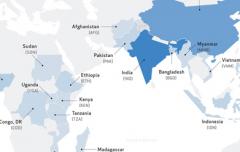Blog: Urban-rural divide and government policies among key challenges in closing global electricity access gap
For most people living in Bandari, a poor neighborhood in western Kenya, sundown often means an unwelcome end to a day. No lamps for reading. No light for cooking.
Consonlata Andhiambo Odero’s tiny hut, which she shares with four children, is a shimmering exception. Discouraged by constant power outages, she bought a small household solar system last fall from M-KOPA Solar. Now she has two lamps for the small shop she runs and pollution-free lights so her kids can read at night. “I’m very much excited,” she said last fall, while showing off her new solar panel that powers her lights and cell phone.
Odero’s home solar system – which she will own after an initial deposit of $30 and 50 cent daily payments for a year – is testament to the tantalizing promise and colossal challenge of providing energy access to one billion people around the world who live without any electricity.
Plummeting costs for decentralized renewable technologies like Odera’s system are a potential game changer in bringing power to the world’s poorest regions. But new energy access ‘heat maps’ created this month by Sustainable Energy for All (SEforALL) make glaringly clear that the global energy access gap is still astonishingly wide. Bold new strategies are needed to bring global populations out of the darkness.
The heat maps target 20 key countries – 16 in Africa and four in Asia – that account for 80 percent of the 1.06 billion people in the world living without electricity, according to energy access data in the 2017 Global Tracking Framework report. Action in these so-called high-impact countries, including India, Bangladesh, Nigeria and Ethiopia, will be critical in achieving the UN’s sustainable development goal of universal access to affordable, reliable, sustainable and modern energy by 2030.
The maps powerfully illustrate the challenge we face. Among the biggest hurdles is the vast urban-rural divide. While urban areas across the world have 96 percent energy access, rural areas far removed from electric grids lag well behind at only 73 percent. The biggest gaps by far are in rural areas of Africa, where nearly 500 million people live without basic power. In many African countries, progress on electrification even lags behind population growth.
While many African countries have rural energy access rates of 5 percent or less, statistics in Asian countries are much stronger, with 70 percent of India’s rural villages getting electricity and 51 percent in Bangladesh. (A caveat on these statistics: electricity in most of these countries can be intermittent, unreliable and generally expensive.)
The heat maps also benchmark the high-impact countries on their policies and overall environments for incentivizing energy access investments, whether for large centralized power plant projects or decentralized renewable systems like M-KOPA’s household solar systems. Countries receiving the highest scores, based on the 2017 Regulatory Indicators for Sustainable Energy (RISE) reporting system, have generally seen the most success in attracting financial support for new energy access projects.
Among the more successful countries is Kenya which has made strong progress the past few years building new power plants and enabling off-grid energy enterprises like M-KOPA which has sold a half-million household solar systems, most of them in rural areas. India and Bangladesh have also made tangible progress with national strategies that are supporting both centralized and decentralized energy access.
By looking at these heat maps together, we hope to show government leaders where some of the opportunities to make the biggest and fastest inroads on energy access, especially in rural areas. Among the clearest lessons is that integrated national strategies, emphasizing both grid-scale projects AND decentralized renewable solutions, are needed to bring energy access to urban and rural populations alike. Governments that eschew the growing promise of off-grid renewables, especially household and mini grid solar offerings, may fall short in achieving broader and faster progress on their goals for energy access for all.
This blog is part of a series to support the launch of new ‘heat maps’ created by SEforALL. The maps identify high-impact opportunities across access to electrification, clean cooking, energy efficiency and renewable energy globally. You can view the heat maps on our website here and follow the conversation online using #SDG7HeatMaps.


